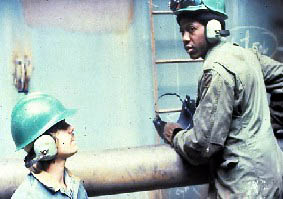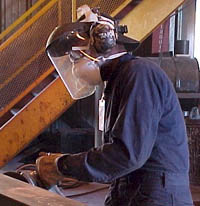Shipyard Employment eTool
PPE Selection >> Hearing Protection

The OSHA Hierarchy of Controls
- Engineering Controls
- Administration Controls
- Personal Protective Equipment (PPE)
Workers exposed to excessive noise must use appropriate PPE including ear plugs, muffs, or both when engineering or administrative controls are not feasible to reduce exposure.
Hearing protection is part of a hearing conservation program, which is required when noise exposure exceeds the action level [85 decibels on the A scale (dBA)].

Potential Hazards
Some operations in the shipyard produce excessive noise, which may lead to hearing loss. Some of the loudest ship repair operations include:
- Abrasive blasting (105-112 dBA)
- Needle gunning (113 dBA)
- Scaling
- Grinding (108-110 dBA)
- Carbon Arcing/Arc gouging (102-118 dBA)
- Pneumatic pumps (100 dBA)
- High-pressure steam cleaning
- Ventilation equipment
Requirements and Example Solutions

- Develop and implement an effective Hearing Conservation Program when action level is exceeded. [29 CFR 1910.95(c)]
- Follow hearing protection requirements. [29 CFR 1910.95(a)]
- Hearing protectors are required when noise levels exceed the OSHA permissible exposure limit (PEL) of 90 dBA measured as a time-weighted average (TWA). [29 CFR 1910.95(b)(1)]
- Hearing protectors must reduce noise to acceptable levels which may require dual use of ear plugs and muffs.[29 CFR 1910.95(j)]
- Review the Noise Reduction Ratings (NRR) for the specific hearing protection devices. [29 CFR 1910.95 Appendix B: Methods for estimating the adequacy of hearing protector attenuation]
-
Note: 5 dB can be added to the NRR of the most protective device when using both ear plugs and muffs.

Figure 4: Ear muffs.
-
Additional Resources
- Noise. OSHA Technical Manual Chapter.
- Occupational Noise Exposure. OSHA Safety and Health Topic Page.
- Guidelines for Noise Enforcement; Appendix A. OSHA Directive CPL 02-02-035 (CPL 2-2.35A), (December 19, 1983).
- Hearing Conservation. OSHA Publication 3074, (2002).
When the worker's noise exposure equals or exceeds an 8-hour time-weighted average of 85 decibels on the A scale (dBA), the employer shall develop and implement a hearing conservation program. [29 CFR 1910.95(c)]
A hearing conservation program consists of the following elements:
- Monitoring noise levels
- Audiometric testing (hearing test)
- Training
- Hearing protection
Additional Resources
- Hearing Conservation. OSHA Publication 3074, (2002).

